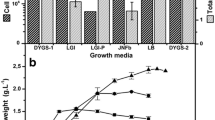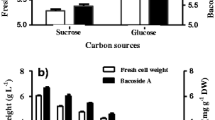Abstract
The red pigment production by Talaromyces purpureogenus KKP, a soil isolate, was optimized by response surface methodology (RSM) in the present study. The cultural parameters, such as pH, temperature, dextrose, and peptone concentrations, were optimized for red pigment production using the central composite design (CCD) experimental design. A second-order quadratic model was used to calculate the relationships between the values at different levels of response. The optimum values of the selected variables under coded factors are 6.0, 27 °C, 2.25%, and 1.10% for pH, temperature, dextrose, and peptone, respectively. The selected variables were most effective in the enhancement of red pigment production at optimized culture conditions. In addition to optimization, the antioxidant activity of the pigment isolated in the present study was found to be promising with IC50 value (40 µg/ml). The HRMS data revealed the identification of delphinidin, limonene, 6-hydroxymethyl-7,8-dihydropterin, d-mannose 6-phosphate, and CDP-DG (18:0/18:0). The results of the present investigation will be added to the existing literature of red pigment production and its optimization by T. purpureogenus





Similar content being viewed by others
References
Gmoser R, Ferreira JA, Lennartsson PR, Taherzadeh MJ (2017) Filamentous ascomycetes fungi as a source of natural pigments. Fungal Biol Biotechnol 4:4. https://doi.org/10.1186/s40694-017-0033-2
Heo YM, Kim K, Kwon SL et al (2018) Investigation of Filamentous Fungi Producing Safe, Functional Water-Soluble Pigments. Mycobiology 46:269–277. https://doi.org/10.1080/12298093.2018.1513114
Mukherjee G, Mishra T, Deshmukh SK (2017) Fungal Pigments: An Overview. In: Satyanarayana T, Deshmukh SK, Johri BN (eds) Developments in Fungal Biology and Applied Mycology. Springer Singapore, Singapore, pp 525–541
Sen T, Barrow CJ, Deshmukh SK (2019) Microbial pigments in the food industry—challenges and the way forward. Front Nutr. https://doi.org/10.3389/fnut.2019.00007
Torres FAE, Zaccarim BR, de Lencastre Novaes LC et al (2016) Natural colorants from filamentous fungi. Appl Microbiol Biotechnol 100:2511–2521. https://doi.org/10.1007/s00253-015-7274-x
Narsing Rao MP, Xiao M, Li W-J (2017) Fungal and bacterial pigments: secondary metabolites with wide applications. Front Microbiol. https://doi.org/10.3389/fmicb.2017.01113
Lian X, Liu L, Dong S et al (2015) Two new monascus red pigments produced by Shandong Zhonghui Food Company in China. Eur Food Res Technol 240:719–724. https://doi.org/10.1007/s00217-014-2376-8
Kim D, Ku S (2018) Beneficial effects of Monascus sp KCCM 10093 pigments and derivatives: a mini review. Mol J Synth Chem Nat Prod Chem. https://doi.org/10.3390/molecules23010098
Embaby AM, Hussein MN, Hussein A (2018) Monascus orange and red pigments production by Monascus purpureus ATCC16436 through co-solid state fermentation of corn cob and glycerol: an eco-friendly environmental low cost approach. PLoS ONE 13:e0207755. https://doi.org/10.1371/journal.pone.0207755
Raja Rajeswari T, Ponnusami V, Kr S (2014) Production of Monascus pigment in low cost fermentation. Int J ChemTech Res 6:2929–2932
Liu B-H, Wu T-S, Su M-C et al (2005) Evaluation of citrinin occurrence and cytotoxicity in Monascus fermentation products. J Agric Food Chem 53:170–175. https://doi.org/10.1021/jf048878n
Patakova P (2013) Monascus secondary metabolites: production and biological activity. J Ind Microbiol Biotechnol 40:169–181. https://doi.org/10.1007/s10295-012-1216-8
Blanc PJ, Laussac JP, Le Bars J et al (1995) Characterization of monascidin A from Monascus as citrinin. Int J Food Microbiol 27:201–213
Frisvad JC, Yilmaz N, Thrane U et al (2013) Talaromyces atroroseus, a new species efficiently producing industrially relevant red pigments. PLoS ONE 8:e84102. https://doi.org/10.1371/journal.pone.0084102
Tam EWT, Tsang C-C, Lau SKP, Woo PCY (2015) Polyketides, toxins and pigments in Penicillium marneffei. Toxins 7:4421–4436. https://doi.org/10.3390/toxins7114421
Liang B, Du X-J, Li P et al (2018) Investigation of citrinin and pigment biosynthesis mechanisms in Monascus purpureus by transcriptomic analysis. Front Microbiol. https://doi.org/10.3389/fmicb.2018.01374
Arai T, Koganei K, Umemura S et al (2013) Importance of the ammonia assimilation by Penicillium purpurogenum in amino derivative Monascus pigment, PP-V, production. AMB Express 3:19. https://doi.org/10.1186/2191-0855-3-19
Chadni Z, Rahaman MH, Jerin I et al (2017) Extraction and optimisation of red pigment production as secondary metabolites from Talaromyces verruculosus and its potential use in textile industries. Mycology 8:48–57. https://doi.org/10.1080/21501203.2017.1302013
Méndez A, Pérez C, Montañéz JC et al (2011) Red pigment production by Penicillium purpurogenum GH2 is influenced by pH and temperature. J Zhejiang Univ Sci B 12:961–968. https://doi.org/10.1631/jzus.B1100039
Hawksworth DL, Lücking R (2017) Fungal diversity revisited: 2.2 to 3.8 million species. Microbiol Spectr. https://doi.org/10.1128/microbiolspec.FUNK-0052-2016
Grijseels S, Nielsen JC, Nielsen J et al (2017) Physiological characterization of secondary metabolite producing Penicillium cell factories. Fungal Biol Biotechnol 4:8. https://doi.org/10.1186/s40694-017-0036-z
Gil MV, Martínez M, García S et al (2013) Response surface methodology as an efficient tool for optimizing carbon adsorbents for CO2 capture. Fuel Process Technol 106:55–61. https://doi.org/10.1016/j.fuproc.2012.06.018
Padmapriya C, Murugesan R (2016) Optimization of parameters for natural red pigment production from Penicillium purpurogenum using cassava waste by central composite design. J Appl Nat Sci 8:1663–1669
Pandey N, Jain R, Pandey A, Tamta S (2018) Optimisation and characterisation of the orange pigment produced by a cold adapted strain of Penicillium sp. (GBPI_P155) isolated from mountain ecosystem. Mycology 9:81–92. https://doi.org/10.1080/21501203.2017.1423127
Santos-Ebinuma VC, Roberto IC, Teixeira MFS, Pessoa A (2014) Improvement of submerged culture conditions to produce colorants by Penicillium purpurogenum. Braz J Microbiol Publ Braz Soc Microbiol 45:731–742. https://doi.org/10.1590/s1517-83822014000200049
Schoch CL, Seifert KA, Huhndorf S et al (2012) Nuclear ribosomal internal transcribed spacer (ITS) region as a universal DNA barcode marker for Fungi. Proc Natl Acad Sci USA 109:6241–6246. https://doi.org/10.1073/pnas.1117018109
Kumar S, Stecher G, Tamura K (2016) MEGA7: molecular evolutionary genetics analysis version 7.0 for bigger datasets. Mol Biol Evol 33:1870–1874. https://doi.org/10.1093/molbev/msw054
Embaby AM, Hussein MN, Hussein A (2018) Monascus orange and red pigments production by Monascus purpureus ATCC16436 through co-solid state fermentation of corn cob and glycerol: an eco-friendly environmental low cost approach. PLoS ONE. https://doi.org/10.1371/journal.pone.0207755
Adebiyi OE, Olayemi FO, Ning-Hua T, Guang-Zhi Z (2017) In vitro antioxidant activity, total phenolic and flavonoid contents of ethanol extract of stem and leaf of Grewia carpinifolia. Beni-Suef Univ J Basic Appl Sci 6:10–14. https://doi.org/10.1016/j.bjbas.2016.12.003
Saeed N, Khan MR, Shabbir M (2012) Antioxidant activity, total phenolic and total flavonoid contents of whole plant extracts Torilis leptophylla L. BMC Complement Altern Med 12:221. https://doi.org/10.1186/1472-6882-12-221
Singh S, Bajaj BK (2017) Potential application spectrum of microbial proteases for clean and green industrial production. Energy Ecol Environ 2:370–386. https://doi.org/10.1007/s40974-017-0076-5
Samson RA, Yilmaz N, Houbraken J et al (2011) Phylogeny and nomenclature of the genus Talaromyces and taxa accommodated in Penicillium subgenus Biverticillium. Stud Mycol 70:159–183. https://doi.org/10.3114/sim.2011.70.04
Yilmaz N, Visagie CM, Houbraken J et al (2014) Polyphasic taxonomy of the genus Talaromyces. Stud Mycol 78:175–341. https://doi.org/10.1016/j.simyco.2014.08.001
Jin H-J, Zhang X, Cao H et al (2018) Chemical composition, security and bioactivity of the red pigment from Penicillium purpurogenum Li-3. Chem Biodivers 15:e1800300. https://doi.org/10.1002/cbdv.201800300
Liu L, Zhao J, Huang Y et al (2018) Diversifying of chemical structure of native Monascus pigments. Front Microbiol. https://doi.org/10.3389/fmicb.2018.03143
Steensels J, Snoek T, Meersman E et al (2014) Improving industrial yeast strains: exploiting natural and artificial diversity. FEMS Microbiol Rev 38:947–995. https://doi.org/10.1111/1574-6976.12073
Author information
Authors and Affiliations
Corresponding author
Ethics declarations
Conflict of interest
The authors declare no conflict of interest.
Additional information
Publisher's Note
Springer Nature remains neutral with regard to jurisdictional claims in published maps and institutional affiliations.
Electronic supplementary material
Below is the link to the electronic supplementary material.
Rights and permissions
About this article
Cite this article
Keekan, K.K., Hallur, S., Modi, P.K. et al. Antioxidant Activity and Role of Culture Condition in the Optimization of Red Pigment Production by Talaromyces purpureogenus KKP Through Response Surface Methodology. Curr Microbiol 77, 1780–1789 (2020). https://doi.org/10.1007/s00284-020-01995-4
Received:
Accepted:
Published:
Issue Date:
DOI: https://doi.org/10.1007/s00284-020-01995-4




